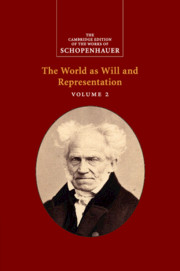Chapter 39 - On the Metaphysics of Music
Published online by Cambridge University Press: 30 June 2022
Summary
In my explanation of the true significance of the wonderful art of music in the passage cited below from the First Volume, a passage which the reader should bear in mind here, I had concluded that although there need be no similarity between its achievements and the world as representation, i.e. nature, there must be a clear parallelism, which I then demonstrated. I will now add some more precise and noteworthy descriptions to that discussion. – The four voices of all harmony, that is bass, tenor, alto, and soprano, or ground note, third, fifth, and octave, correspond to the four levels in the series of beings, which is to say the mineral world, plant kingdom, animal kingdom and human beings. This view receives a striking confirmation in the fundamental musical rule that the bass is supposed to remain at a much greater distance from the three higher voices than these are from each other, so that it is never supposed to get any closer to these than the distance of an octave, and usually remains further, and the proper triad has its place in the third octave above the bass note. Accordingly, the effect of extended harmony, where the bass remains further away, is much more powerful and beautiful than that of close harmony, where it is brought into greater proximity; close harmony is introduced only due to limited instrumental range. This entire rule is however in no way arbitrary but is rooted in the natural origin of the tonal system, insofar as the nearest harmonic intervals are the octave and its fifth, which sound simultaneously by means of the harmonics. In this rule, we recognize the musical analogue of the basic constitution of nature by virtue of which organic creatures are much more closely related to each other than to the lifeless, inorganic masses of the mineral world; between it and them the most decided boundaries and the widest gaps in the whole of nature can be found. –
- Type
- Chapter
- Information
- Schopenhauer: The World as Will and Representation , pp. 464 - 474Publisher: Cambridge University PressPrint publication year: 2018

